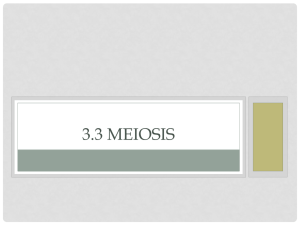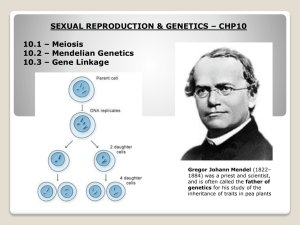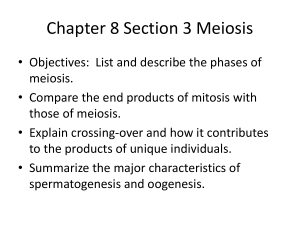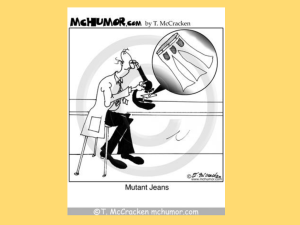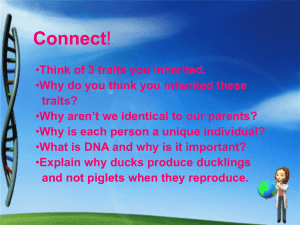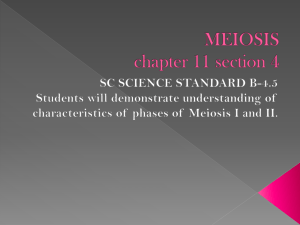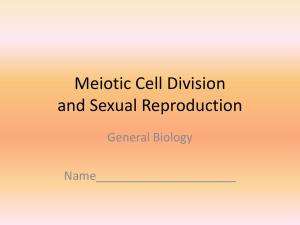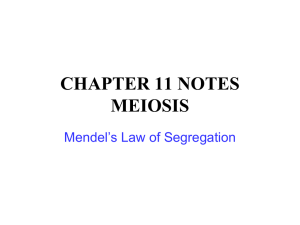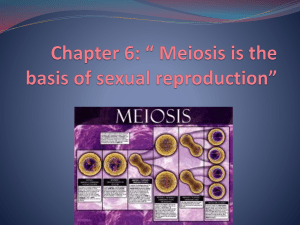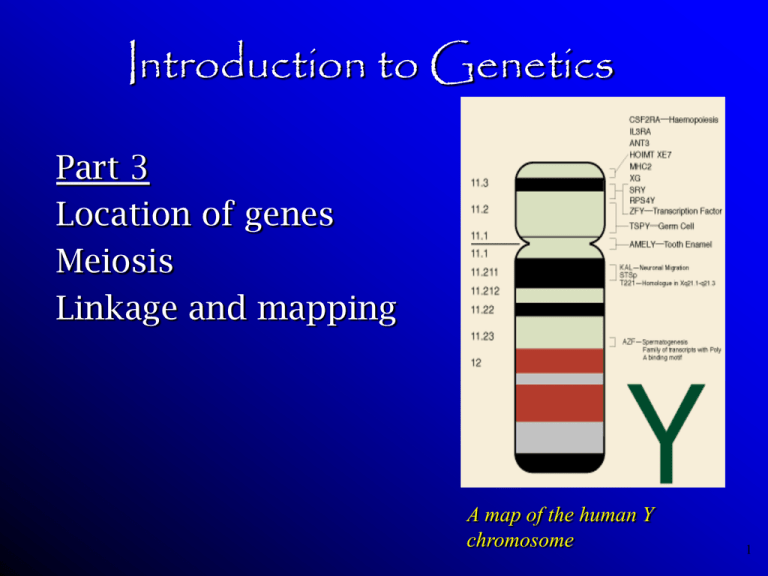
Introduction to Genetics
Part 3
Location of genes
Meiosis
Linkage and mapping
A map of the human Y
chromosome
1
Location of genes
• One of the things Mendel didn’t solve was exactly where genes are
located in cells. His precise description of how genes behaved,
though, helped other scientists determine that genes are on
chromosomes.
• Normal body cells have two copies of each chromosome. These
copies are NOT identical, since they may carry different alleles for
the genes they have. We say that these two chromosomes are
homologous (meaning “similar in appearance, structure, and
function”), and each comes from a different parent.
• When a cell has both sets of homologous chromosomes, we say it is
diploid (“two sets”) and give it a symbol for chromosome number:
2N
• Current estimates are that humans have around 25,000-30,000
genes. Since we have 23 homologous pairs of chromosomes, this is a
little over 1000 genes per chromosome (One allele of a gene on each
copy of a particular chromosome).
• For humans, 2N = 46. For fruit flies (four chromosomes) 2N = 8. Peas
have seven pairs, so 2N = 14.
2
Human female karyotype
3
Gamete Formation: Meiosis
• Gametes (sex cells like eggs and sperm), though, only
carry one copy of each chromosome, so we call them
haploid (“one set”), with the symbol N. For us, the
haploid number is N=23.
• What is the haploid number for fruit flies or peas?
• How does that happen, since body cells have both sets?
• In making gametes, there is an extra round of cell
division WITHOUT duplication of chromosomes. This is
sometimes called a reduction division. 2N gets split to N,
making diploid cells into haploid cells.
• This specialized cell division process that results in
gametes is called meiosis.
http://www.sumanasinc.com/webconte
nt/anisamples/majorsbiology/meiosis.h
4
tml
Meiosis I
Most of what happens is like mitosis, and uses the same machinery.
The main differences:
Pairs of homologous chromosomes (called tetrads) line up together during Metaphase I.
These were already duplicated during interphase, so each tetrad consists of four copies of
the chromosome. At Anaphase I the homologous chromosomes move apart (centromeres
do not split).
The daughter cells produced by Meiosis I are now haploid.
This is followed by a meiotic interphase. No DNA/Chromosome duplication occurs.
5
Meiosis II
Meiosis II is essentially just mitosis and the sister chromatids that remained together
during Meiosis I now separate.
At the end of meiosis, from one original diploid cell, we now have four haploid cells.
Since they contain single copies of homologous chromosomes, they are NOT
identical.
Remember: sister chromatids are identical since they are exact copies of each other,
but homologous chromosomes are not identical, since one comes from each parent.
6
Male gametes in
animals are sperm. In
some plants they are
pollen.
Female gametes in
animals are eggs,
while in some plants
they are egg cells.
At right:
Products of meiosis
are different in male
and female animals.
7
• Another look
at Meiosis
showing
segregation of
alleles.
8
Mitosis vs. Meiosis
9
Quickcheck
• What do haploid and diploid mean?
• What are the haploid and diploid numbers for humans?
• What are the products of meiosis?
• Why do we call meiosis a reduction division?
• What do we call the two main parts of meiosis?
• What is a tetrad and when does it exist?
10
Quickcheck
• What do haploid and diploid mean?
One and two sets of chromosomes.
• What are the haploid and diploid numbers for humans?
n=23 2n=46
• What are the products of meiosis?
Gametes (sex cells)
• Why do we call meiosis a reduction division?
Because the final products are haploid cells (the number
of copies of each chromosome has been reduced)
• What do we call the two main parts of meiosis?
Meiosis I and Meiosis II
• What is a tetrad and when does it exist?
A homologous pair of duplicated chromosomes (four
chromatids; tetra = four)
11
Crossing Over
2 ABCDE
2 abcde
Recombination
1 ABCDE (parental type)
1 ABcde (recombinant)
1 abCDE (recombinant)
1 abcde (parental)
One interesting and important event can happen during Meiosis I at the tetrad
stage: Chromatids can sometimes exchange parts (called “crossing over”). This
can result in chromatids (and gametes) with different combinations of genes or
alleles than they originally had. This is one way new genetic combinations can
occur. This process is also called recombination, and the chromatids that are
now different from the parental types are called recombinants.
12
13
14
Gene Linkage
Mendel said genes independently assort, but it is really
chromosomes that do this. Genes on different
chromosomes are independent. If two or more genes are
on the same chromosome, though, they are physically
linked, and tend to stay together in crosses (genetically
linked).
This was first discovered by Thomas Hunt Morgan and his
students, using fruit flies (Drosophila melanogaster) as a
test subject. They noticed that there were four different
groups of genes that tended to stay together (=linkage
groups), and they already knew that Drosophila have four
chromosomes.
From this they concluded that chromosomes are essentially
a group of linked genes.
It is only when a cross-over occurs between them that
linked genes don’t stay together.
15
Linkage mapping
• One of Morgan’s students, Alfred Sturtevant, realized
that there was a pattern to when crossing over occurred.
• The farther apart two genes are on a chromosome, the
higher the chance that a crossover will occur between
them.
• He further realized that this information could be used
to make a map of where genes are on a chromosome.
• 1% recombination between two genes = 1 “map unit” of
distance between them.
• For instance: there is 13% recombination between prune
eye (pr) and vestigial wing (vg) in Drosophila, so they are
13 m.u. (map units) apart on the same chromosome. We
can draw the map:
16
Linkage mapping
• In this way, we can make maps of where genes
are on the chromosomes.
• One note: Genes on different chromosomes do
assort independently, so they seem to have a
“recombination” rate of 50%.
• For this reason, genes that really are on the
same chromosome, but 50 or more map units
apart, will act like they are on separate
chromosomes. We would say that they are
physically linked (on same chromosome) but not
genetically linked (because they do
independently assort).
17
Linkage mapping
•A linkage map of selected genes (written as descriptions, not genotypes) on
Drosophila melanogaster’s Chromosome 2.
•Notice that the total length of the chromosome is 110 map units.
•What percent recombination would you expect between the Purple eye and Curved
wing genes?
18
Quickcheck
• What is crossing over?
• What did Morgan conclude about genes and
chromosomes?
• What can we conclude if there is 23% recombination
between the long nose and floppy ear genes of imaginary
aardvarks?
• What if the recombination rate was 50%?
19
Quickcheck
• What is crossing over?
During the tetrad stage, parts of chromosomes can be
exchanged. This may change the combination of alleles
on the chromosome.
• What did Morgan conclude about genes and
chromosomes?
Chromosomes are groups of linked genes.
• What can we conclude if there is 23% recombination
between the long nose and floppy ear genes of imaginary
aardvarks?
They are on the same chromosome and 23 map units
apart.
• What if the recombination rate was 50%?
Either more than 50 m.u. apart OR on different
chromosomes.
20
Meiosis Animations
• http://highered.mcgrawhill.com/sites/0072495855/student_view0/chapt
er28/animation__how_meiosis_works.html
• http://www.sumanasinc.com/webcontent/anisa
mples/majorsbiology/meiosis.html
• http://www.biology.arizona.edu/cell_bio/tutorials
/meiosis/main.html
21

